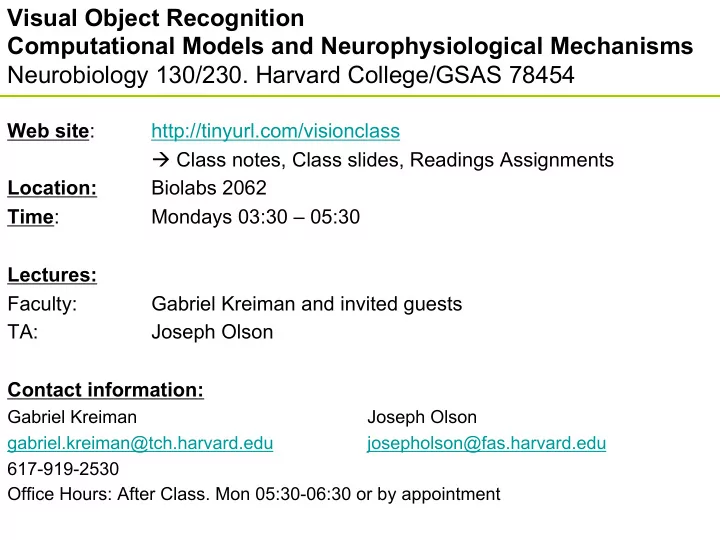

Visual Object Recognition Computational Models and Neurophysiological Mechanisms Neurobiology 130/230. Harvard College/GSAS 78454 Web site : http://tinyurl.com/visionclass à Class notes, Class slides, Readings Assignments Location: Biolabs 2062 Time : Mondays 03:30 – 05:30 Lectures: Faculty: Gabriel Kreiman and invited guests TA: Joseph Olson Contact information: Gabriel Kreiman Joseph Olson gabriel.kreiman@tch.harvard.edu josepholson@fas.harvard.edu 617-919-2530 Office Hours: After Class. Mon 05:30-06:30 or by appointment
Visual Object Recognition Computational Models and Neurophysiological Mechanisms Neurobiology 130/230. Harvard College/GSAS 78454 Lectures + Class Discussion [20% of grade] Reading assignments. [60% of grade] One paper per class. Total of 10 reading assignments Write two paragraphs about the paper: Paragraph 1: Discuss one missing control or one problem with the interpretation. Paragraph 2: Discuss a logical follow-up question. Note: Do not copy and paste the paper. We have already read it. Final Exam [20% of grade]
Visual Object Recognition Computational Models and Neurophysiological Mechanisms Neurobiology 230. Harvard College/GSAS 78454 Class 1. Sep-12 Introduction to pattern recognition. Why is vision difficult? Visual input. Natural image statistics. The retina. [Kreiman] Class 2. Sep-19 Lesion studies in animal models. Neurological studies of cortical visual deficits in humans. [Kreiman] Class 3. Sep-26 Psychophysics of visual object recognition [Joseph Olson] Class 4. Oct-03 Introduction to the thalamus and primary visual cortex [Camille Gomez-Laberge] Oct-10 Columbus Day. No class. Class 5. Oct-17 Adventures into terra incognita . Neurophysiology beyond V1 [Jiye Kim] Class 6. Oct-24 First steps into inferior temporal cortex [Carlos Ponce] Class 7. Oct-31 From the highest echelons of visual processing to cognition [Leyla Isik] Class 8. Nov-07 Correlation and causality. Electrical stimulation in visual cortex. Class 9. Nov-14 Theoretical neuroscience. Computational models of neurons and neural networks. [Bill Lotter] Class 10. Nov-21 Computer vision. Towards artificial intelligence systems for cognition [David Cox] Class 11. Nov-28 Computational models of visual object recognition. [Kreiman] Class 12. Dec-05 [Extra class] Towards understanding subjective visual perception. Visual consciousness.
Visual Object Recognition Computational Models and Neurophysiological Mechanisms Neurobiology 230. Harvard College/GSAS 78454 Recommended books Suggested Books Ullman S (1996) High-level vision. MIT Press. Wandell BA (1995) Foundations of vision. Sunderland Sinauer Associates. Chalupa LM and Werner JS (editors) (2003). The Visual Neurosciences. MIT Press. Frisby and Stone (2010). Seeing. MIT Press. Kriegeskorte and Kreiman (2011). Visual population codes. MIT Press. Other good books Purves and Lotto. (2003). Why we see what we do. Sinauer Books. Deco and Rolls (2004). Computational Neuroscience of Vision. Oxford University Press. Ripley. Pattern recognition and neural networks (1996). Cambridge University Press. Rao, Olshausen and Lewicki (eds) (2002). Probabilistic models of the brain. MIT Press. Koch C (2005) The quest for consciousness. Roberts & Company Publishers. Regan (2000) Human perception of objects. Sinauer Books. Dayan and Abbott (2002). Theoretical Neuroscience. MIT Press.
Academic Integrity Policy All reading assignments will be discussed in class. During class, collaboration and discussion is not only permitted but actually encouraged. After class, each student must prepare the homework on his/her own. Students should be aware that in this course collaboration of any sort on any work submitted for formal evaluation is not permitted. This means that you may not discuss your problem sets, paper assignments, exams, or any other assignments with other students. All work should be entirely your own. The use of textbooks, books and articles is encouraged. Students must use appropriate citation practices to acknowledge the use of books, articles, websites or lectures, that were consulted to complete your assignments.
Reading Assignment 1 Warrington, E., and Shallice, T. Category specific semantic impairments. Brain. 107:829-854 (1984) Discussion: Monday 09/19 Reading assignment due: Monday 09/26 Assignment due by email: josepholson@fas.harvard.edu File formats: Word, Latex, Text, PDF File name = <your_last_name>_Assignment<#>.<fileextension> NO EXTENSIONS. Reading Assignments Link
Recommend
More recommend